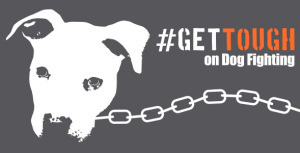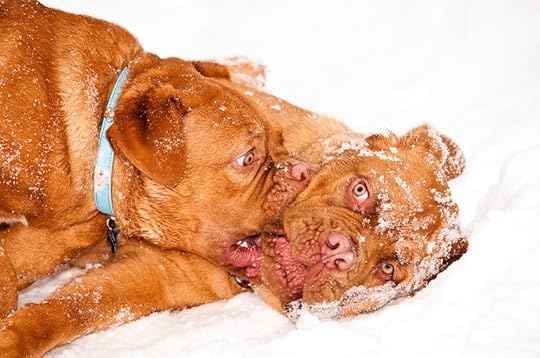5 Kinds of Dog Aggression: Get Tough on Dog Fighting

Images courtesy of DepositPhotos.com
April 8th is DOG FIGHTING AWARENESS DAY, and it’s a good time to review the 5 common kinds of dog aggression and what to do. According to the ASPCA, dog fighting happens all over the country and in all kinds of communities–rich, poor, middle class, it doesn’t matter, it’s there festering just beneath the surface. When fight rings are located, cases are built, offenders are prosecuted, and abuse survivors find loving homes. In 2014, the Department Of Justice prosecuted 10 federal dog fighting cases and secured the longest sentence (8 years) ever received in a federal dog fighting case. Learn more here.

Image Courtesy of ASPCA
In an effort to stamp out this cruel “sport” (yes, that’s what proponents call it, can you imagine?!), the #GetTough on Dog Fighting campaign offers free information and ways for all animal lovers to get involved.
Hey, dog fighting isn’t just about one breed. It impacts ALL dog owners–and cat lovers, too, because dogs are trained to fight by “practicing” on other animal victims. Spectators even bring kids to the fights to introduce them to the sport. *wiping eyes* The thought makes me weep with anger. So my next novel SHOW AND TELL shines a light on this dirty practice.
5 Kinds of Dog Aggression
Here’s the deal. Aggression is a NORMAL part of being a dog, and while dog-on-dog aggression is more prevalent in some breeds, ALL dogs have the potential to fight and bite. Aggression can arise out of pain or health issues. Growly dogs believe they have a good reason to aggress (they often do!) whether owners agree or not.
Aggression can be complicated and require professional help, but here’s how to recognize 5 common types and learn how to keep the peace.
 Play Aggression looks scary but dogs tell each other it’s just pretend by using gestures like the play bow (butt up, front down). Puppies learn to inhibit bites when they play with other dogs, and owners also can teach limits.
Play Aggression looks scary but dogs tell each other it’s just pretend by using gestures like the play bow (butt up, front down). Puppies learn to inhibit bites when they play with other dogs, and owners also can teach limits.
If the mouthing hurts, YELP like another puppy. Whimper and say, “You hurt me.” Immediately after you yelp, give the dog a 10-minute time out—no mouthing allowed—to teach him that hard bites make the fun stop.
Predatory Aggression includes stalking, chasing, catching and biting like in play, but predatory dogs won’t play bow—they’re deadly serious. Joggers, bicyclist, and moving cars and cries of young children, babies and smaller pets can trigger prey drive.
Predatory behavior may go away as the youngster grows up, but keep targets safe with strict supervision. Identify triggers (like joggers) and avoid them. Teach dogs to control natural impulses with obedience drills. A “happy” word the dog can’t resist (ball, cookie, ride) can often change the dog’s attitude and interrupts the behavior.
 Fear Aggression results when a dog can’t escape a scary situation. Caged, chained or cornered dogs often bite out of fear. Snarls, growls or bites make the scary “thing” go away, which rewards the dog so she’ll repeat the behavior. Reaching for the scared dog’s collar almost always prompts a bite, because a hand descending toward the head looks threatening.
Fear Aggression results when a dog can’t escape a scary situation. Caged, chained or cornered dogs often bite out of fear. Snarls, growls or bites make the scary “thing” go away, which rewards the dog so she’ll repeat the behavior. Reaching for the scared dog’s collar almost always prompts a bite, because a hand descending toward the head looks threatening.
Avoid petting on the top of the head. Instead, pet the dog’s sides or chest. Don’t stare, which can intensify intimidation. Play builds confidence, so teach “fetch” while avoiding tug-games that can encourage fear biting behavior. Use pheromone therapy such as Comfort Zone with DAP to help calm fears.
Territorial aggression typically involves herding and protection breeds. Dogs bark, lunge and growl at the fence or doorway, and are rewarded when the mailman, new dog, or your fiancé goes away. Conspire with visitors so the outcome changes.
Have the mailman toss treats to the dog, but without making eye contact or saying anything. Once the dog quiets to munch the treat, the mailman can say, “Good Rex!” and walk away. He should NOT walk away as long as the dog barks and lunges. If Rex ignores the treat and continues to bark and lunge, then YOU call the dog and reward him with a treat or toy for coming. The mailman leaves as the dog retreats—so essentially neither won.
Guarding Food, Toys, Furniture are all part of dominance aggression. These dogs often object to being restrained—as for nail trims—and the aggression can gets worse with punishment or confrontation. They’re often young intact male dogs who want to call the shots with people, but then tremble or seem to act “remorseful” afterwards. An argument over toys or mealtime that prompts a first instinctive snarl teaches the dog that aggression keeps others a safe distance from important resources.
Dominance aggression can be complicated and dangerous to solve and usually requires a professional. Neutering the dog and managing resources can help. If the dog protects toys, remove them so he has nothing to guard. Require the dog to “earn” privileges by paying with good behavior. For instance, ask him to “sit” (he sits), which earns him what he wants (attention/food bowl/open door/verbal praise). He should get NOTHING unless he earns it by responding in a positive way to your command.
Are dog fights a problem in your community? Have you ever had an issue with aggression in your dogs or in a dog that belongs to someone else? How did you handle it?
I love hearing from you, so please share comments and questions. Do you have an ASK AMY question you’d like answered–lick the banner, above. Be sure to visit my PetHealthyStore for paw-some products for your furry wonders! Stay up to date on all the latest just subscribe the blog, “like” me on Facebook, and get a FREE BOOK when you sign up for Pet Peeves newsletter. Stay up to date with the latest book give aways, kewl product offers, and appearances related to my THRILLERS WITH BITE!




